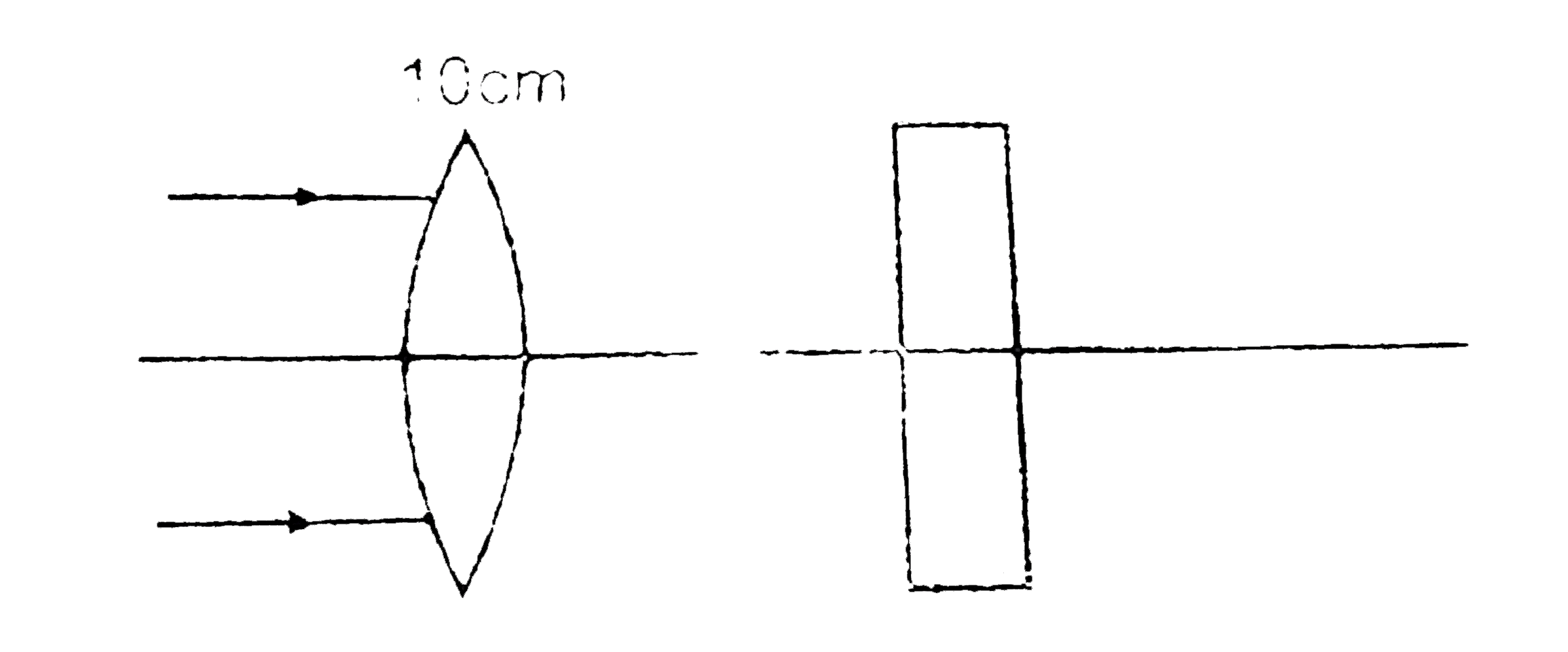A ray of light falls at an angle of 30∘ onto a plane-parallel glass plate and leaves it parallel to the initial ray. The refractive index of the glass is 1.5. What is the thickness of d of the plane if the distances between the rays is 3.82cm ? [Given: sin−1(13)=19.5∘,cos19.5∘=0.94,sin10.5∘=0.18]
To solve the problem step by step, we will follow these instructions:
Step 1: Understand the Geometry of the Problem
We have a ray of light incident at an angle of 30∘ on a plane-parallel glass plate with a refractive index of 1.5. The ray exits the plate parallel to its original path. We need to find the thickness d of the glass plate given that the distance between the incident and the refracted rays is 3.82cm.
Hint: Draw a diagram to visualize the incident ray, the refracted ray inside the glass, and the exiting ray.
Step 2: Apply Snell's Law
Using Snell's law, we can find the angle of refraction r when the ray enters the glass. Snell's law is given by:
μ=sinisinr
Where:
- i=30∘ (angle of incidence)
- μ=1.5 (refractive index of glass)
Substituting the values:
1.5=sin30∘sinr
Since sin30∘=12, we have:
1.5=12sinr
Rearranging gives:
sinr=13
Hint: Remember that sinr can be calculated directly from the equation derived from Snell's law.
Step 3: Calculate the Angle of Refraction
Now we find r using the inverse sine function:
r=sin−1(13)
From the problem statement, we know that:
r=19.5∘
Hint: Use the provided value for sin−1(13) to confirm your calculations.
Step 4: Calculate the Deviation
The deviation s between the incident and the refracted rays can be expressed as:
s=d⋅sin(i−r)cosr
Substituting i=30∘ and r=19.5∘:
s=d⋅sin(30∘−19.5∘)cos(19.5∘)
Calculating 30∘−19.5∘=10.5∘:
s=d⋅sin(10.5∘)cos(19.5∘)
Hint: Make sure to calculate the sine and cosine values using the provided values.
Step 5: Rearranging the Equation for Thickness d
We can rearrange the equation to solve for d:
d=s⋅cos(19.5∘)sin(10.5∘)
Substituting the known values:
- s=3.82cm
- cos(19.5∘)=0.94
- sin(10.5∘)=0.18
Thus,
d=3.82⋅0.940.18
Hint: Ensure you perform the multiplication and division accurately to find d.
Step 6: Calculate the Thickness d
Now, calculating d:
d=3.82⋅0.940.18≈20cm
Final Answer: The thickness d of the glass plate is 20cm.
We have a ray of light incident at an angle of 30∘ on a plane-parallel glass plate with a refractive index of 1.5. The ray exits the plate parallel to its original path. We need to find the thickness d of the glass plate given that the distance between the incident and the refracted rays is 3.82cm.
Using Snell's law, we can find the angle of refraction r when the ray enters the glass. Snell's law is given by:
- i=30∘ (angle of incidence)
- μ=1.5 (refractive index of glass)
Now we find r using the inverse sine function:
The deviation s between the incident and the refracted rays can be expressed as:
We can rearrange the equation to solve for d:
- cos(19.5∘)=0.94
- sin(10.5∘)=0.18
Now, calculating d:
Topper's Solved these Questions
- BOOK - RESONANCE ENGLISHCHAPTER - GEOMATRICAL OPTICS EXERCISE - Exercise-1141videos
GEOMATRICAL OPTICS
- BOOK - RESONANCE ENGLISHCHAPTER - GEOMATRICAL OPTICS EXERCISE - Exercise-262videos
GEOMATRICAL OPTICS
- BOOK - RESONANCE ENGLISHCHAPTER - GEOMATRICAL OPTICS EXERCISE - Advance level Problems35videos
GEOMATRICAL OPTICS
- BOOK - RESONANCE ENGLISHCHAPTER - EXPERIMENTAL PHYSICSEXERCISE - PART -II10videos
EXPERIMENTAL PHYSICS
- BOOK - RESONANCE ENGLISHCHAPTER - GRAVITATIONEXERCISE - HIGH LEVEL PROBLEMS16videos
GRAVITATION
Similar Questions
A ray of light falls on a glass plate of refractive index μ=1.5.
What is the angle of incidence of the ray if the angle between the reflected and
refracted rays is 90∘?View SolutionA ray of light falls on a glass plate of refractive index μ=1.5.
What is the angle of incidence of the ray if the angle between the reflected and
refracted rays is 90∘?View SolutionA light ray is incident at 45∘ on a glass slab. The slab is 3cm thick, and the refractive index of the glass is 1.5. What will the displacement of the ray be as a result of its passage through the slab? At what angle will the ray emerge formn the slab?
View SolutionThe speed of light in air is 3×108ms−1. Calculate the speed of light in glass. The refractive index of glass is 1⋅5.
View SolutionIf the refractive index of glass is 1.5. Find the velocity of light in glass. (Velocity of light in vacuum =3×108m/s)
View SolutionA ray of light strikes a glass slab 5 cm thick, making an angle of incidence equal to 30∘.
(a) Draw a ray diagram showing the emergent ray and the refracted ray through the glass block. The refractive index of glass is 1⋅5.
(b) Measure the lateral displacement of the ray. The sin 19⋅5∘=1/3.View SolutionA ray of light 10−9 second to cross a glass slab of refractive index 1.5. The thickness of the slab will be
View SolutionA parallel beam of light is incident on a lens of focal length 10 cm. A parallel slab of refractive index 1.5 and thickness 3 cm is placed on the other side of the lens. Find the distance of the final image from the lens.
 .View Solution
.View SolutionIn a young 's double slit experiment, a glass plate of refractive index 1.5 and thickness 5×10−4 cm is kept in the path of one of the light rays. Then
View SolutionA circular beam of light of diameter d=2cm falls on a plane refractive of glass. The angle of incidence is 60∘ and refractive index of glass is μ=3/2. The diameter of the refracted beam is
View Solution

